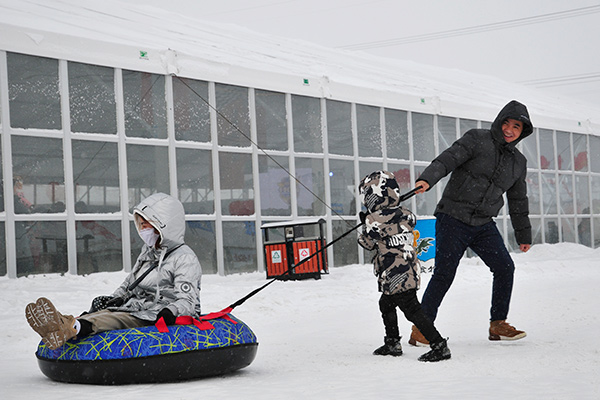A festival frozen in time


Tourists find the city of Hulunbuir is a winter wonderland. [PHOTO BY XU LIN/CHINA DAILY]
The celebrations include activities with such themes as music, folklore, photography and outdoor sports.
Visitors can ski and fish, and ride dog sleds and snowmobiles.
The traditional festival-nadam translates from Mongolian as "entertainment" or "recreation"-features horse races, wrestling matches and archery contests. It's staged twice a year-once in summer and once in winter.
Hulunbuir is an ideal destination for carnivores. It's known for its beef, mutton and lamb chops washed down with salty milk tea.
Boiled beefsteaks are dipped in sauce with chives or served with potatoes. Lamb legs are smoked for three hours to absorb the seasonings.
Hulun Lake abounds with such aquaculture as white fish and white shrimp, which are often deep-fried. White mushrooms are harvested in August and September, and dried for winter.
Downtown Hulunbuir is two hours' drive from Manzhouli, a major land port on the border with Russia with a tax-free zone.
Manzhouli's China-Russia-Mongolia Ice Snow Festival will last until February.
It features 110 ice and snow sculptures illuminated with colorful lights at night. Visitors to the land port can purchase inexpensive Russian goods like chocolate.
Travelers visit the border gate, No 41 Boundary Monument and nearby Russian towns.
Matryoshka Square hosts a 30-meter-high building in the shape of a nesting doll painted with three faces-ethnic Han, Mongolian and Russian-looking in different directions.
The square also features over 200 smaller doll statues and ornate Easter eggs.
A nearby hotel is also shaped like a nesting doll and decorated according to the theme-lamps, doors and closets are all shaped like the toys.
MOST POPULAR
- 1 China to give visa-free treatment to another 9 countries
- 2 China fully opens manufacturing sector to foreign investors in landmark opening up move
- 3 China's import expo attracts record-breaking participating countries, exhibitors
- 4 China's door opening even wider to foreign visitors, businesses
- 5 China revises rules to ease foreign strategic investment in listed firms
Editors' Picks
 Infographic:
China's public holidays for 2025
Infographic:
China's public holidays for 2025
 Infographic:
Basic facts of APEC
Infographic:
Basic facts of APEC
 Infographic:
Wrapping up the 7th CIIE: Data recap
Infographic:
Wrapping up the 7th CIIE: Data recap




